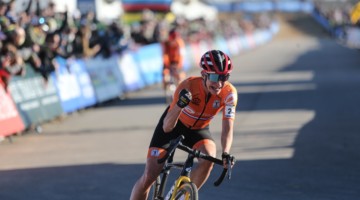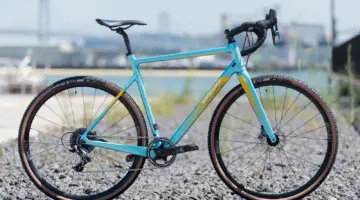Kona started as a mountain bike company in the late 1980s, but it was also one of the first companies to offer a production-level cyclocross bike. The company’s Jake the Snake dates back to at least the 1999 model year—with the famed green Michelin mud tires stock—and it continues to this day.
Kona’s cyclocross bikes have evolved over the past 20 years (although some of us might still be envious of those stock Michelin Muds). A few of years ago we looked at Helen Wyman's Super Jake that was Kona's first foray into disc brakes, and for the 2018 model year, Kona went back to the drawing board and did an overhaul on the geometry and build of its ’cross bikes.
We first saw the new 2018 Kona Major Jake at the Sea Otter Classic last year, and we also got to experience it first-hand with Barry Wicks, Kerry Werner and Spencer Paxson in Squamish, B.C. last August. Since then, we have also profiled Werner’s Super Jake and Scott Funston’s 2014 Kona Major Jake that helped him to a silver at Junior Nationals.

We profiled Scott Funston's Kona Major Jake B bike at the 2018 Reno Cyclocross Nationals. Junior 17-18 Men. 2018 Cyclocross National Championships. © C. Lee / Cyclocross Magazine
Kona’s cyclocross line features three bikes in the Super Jake, Major Jake and Jake the Snake. Kona simplified the 2018 line by giving the three bikes the same geometry. Two of the biggest changes were adding more bottom bracket drop and a slacker head tube angle in the front.
Our Cyclocross Magazine team has ridden Kona’s mid-level carbon Major Jake with a Shimano 105 groupset and WTB i19 wheels. Read on for our impressions of Kona’s modern take on its classic model as both a cyclocross and gravel crossover platform.
Stay tuned for more, as we are hoping to see Kona's 2019 line at Sea Otter this weekend.

The $3,000 2018 Kona Major Jake cyclocross bike with a Shimano 105 groupset. © C. Lee / Cyclocross Magazine
The Frame
The Major Jake received a major redesign for the 2018 model year. Kona gave the bike modern fixtures such as front and rear thru-axles and flat mount disc brake calipers. It also dropped the bottom bracket and added two degrees of slack to the head tube angle, giving it a somewhat unique design for cyclocross.
The 2018 Kona Major Jake has an all-carbon monocoque frame that is the same as that of the top-end Super Jake model. The 56cm frame has a claimed weight of 1,080g.
First thing to know is that the sizing of the new line is not what you would expect. You'll probably size down. If you ride a 56cm, you'll want the 54cm, as we did. Barry Wicks, at 6'4" rides a 58cm, which is Kona's largest frame for the new line.
Our medium (54cm) review bike has a 56.2cm top tube length mated to 54cm seat tube. The medium carbon Jake has a tall head tube that tapers from 1 ⅛" to 1 ½" and the frame has a matching all carbon fork with a standard-for-’cross 45mm offset.

Kona went to flat mount disc brake mounts for its 2018 cyclocross bikes. 2018 Kona Major Jake cyclocross bike. © C. Lee / Cyclocross Magazine
The unique part of the front end is the slack 70.2-degree head tube angle which is 2 degrees slacker than the previous iteration of the carbon Jake frame. This combination of head angle and fork offset yields a long 70mm trail—which is about 10mm longer than usual cyclocross geometry—and gives a long front center of 622mm with a long 103.8cm wheelbase. Cannondale was the first to use this slack front geometry but utilized a 55mm fork offset to arrive at a more common 60mm trail.
The carbon Jake frame has a 8mm lower bottom bracket than the last model, with a drop of 7cm that is more common on modern American ’cross bikes. With the tall head tube, this gives a 580mm stack height, which is not too much higher than we see with other bikes, and our medium has a reach of 390mm. Other geometry parameters are not too far off from the norm with 42.5mm chainstays and a 73.5 degree seat tube angle.
All frame control lines run internally, entering at the downtube and are accessible via a screwed-on hatch at the bottom bracket. The area behind the bottom bracket is clean and smooth and sculpted beginning at the middle of the seat tube for mud and tire clearance.
Chainstay clearance is usually the limiter for tire width since there is chain ring clearance on the drive side to contend with. The BB86 bottom bracket allows ample clearance on the carbon Jake frame for up to a 42mm tire, and the bridge on the wide-spaced seatstays sits high above the tire.

The Major Jake has plenty of tire clearance, making it a potential option for a gravel crossover. 2018 Kona Major Jake cyclocross bike. © C. Lee / Cyclocross Magazine
The front brake line runs externally and ties to the fork with a small clamp below the crown. We like the external brake line on the fork so we can swap to a suspension fork or change brake calipers easily if we need to Both the fork and frame have flat mount disc brake caliper mounts and the fork and frame have 12x100mm and 12x142mm thru-axles, respectively. The all-carbon front fork has a claimed weight of 460g.
Two sets of water bottle mounts are in the usual place of the down and seat tubes, and Kona put threaded fender mounts on the fork crown and bottom bracket and fork blades and rear dropouts. Interestingly, there is nothing on the seatstay bridge to tie the top of the fender, so the user will have to fashion a mount or let it float free.
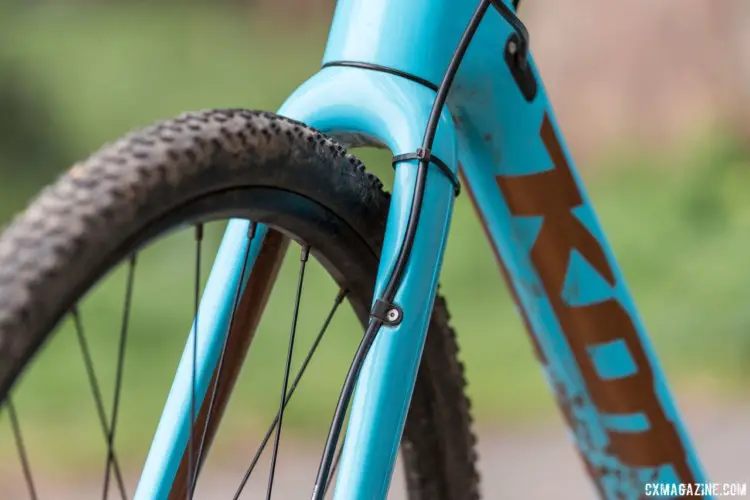
The brake line runs externally along the front fork. 2018 Kona Major Jake cyclocross bike. © C. Lee / Cyclocross Magazine
The Build
The Major Jake is the second tier model of Kona’s Jake line of cyclocross bikes. It shares the same frame as the top-tier Super Jake, but sells for $3,000, which is $1,000 less than the Super Jake. The biggest differences? The Super Jake has a SRAM Force 1 groupset and Clement Ushuaia wheelset, while the Major Jake has a 2x Shimano 105 build with WTB i19 wheels.
The drivetrain on our 2018 model is Shimano 105 5800 with matching ST-RS505 hydraulic brake/shift levers and BR-RS505 flat mount hydraulic calipers. Both the front and rear rotors are 160mm.
The 105 5800 groupset is a smooth-shifting setup we have ridden quite a bit in the past. In our experience, the long arm of the front derailleur can interfere with wide tires on some bikes when it swings down to bring the chain to the large chain ring, but on the Major Jake it is not a problem even with a 42mm tire in place.

The Major Jake comes stock with a Shimano 105 drivetrain and RS500 crankset. 2018 Kona Major Jake cyclocross bike. © C. Lee / Cyclocross Magazine
The 5800 series 105 levers have a bulky and bulbous design with the shifting mechanism put in front of the hydraulic master cylinder, making the lever quite long. Their forward length reminds me of the Dura Ace 7800 and Ultegra 6600 levers of a decade ago. There is plenty of lever body to hold, but it is a bit bulkier due to the hydraulic cylinder. Despite the appearance, I did not notice the lever weight high or forward of the handlebar and liked the grip size.
The GS long cage rear derailleur allows shifting across the included 11-32t 11-speed cassette with the 46/36t chain rings on a Shimano RS500 5-arm crankset. I prefer a 4-arm 5800 crank for better aesthetics, but cost made the decision here and certainly does not affect shifting.
The cockpit is all aluminum Kona-branded items with a 10cm stem mated to a bar that flares from 42cm at the hoods to 50cm at the drops. The seatpost has a two-bolt seat clamp and a narrow but well-padded WTB SL8 Pro saddle sits on top.
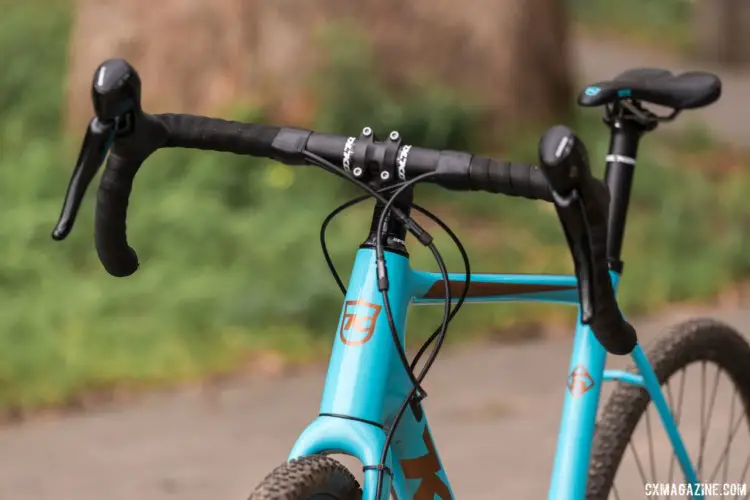
The headtube puts the handlebar up higher than on some other bikes. 2018 Kona Major Jake cyclocross bike. © C. Lee / Cyclocross Magazine
The stock wheelset is a nice tubeless setup, even if it is not necessarily the lightest with an estimated weight around 1,900g. It uses aluminum WTB i19 Asym rims laced to Formula CenterLock hubs with straight gauge spokes, 1.8mm in front and 2.0 on the rear. It was a nice thought to use different gauge spokes, but using 2.0/1.8 double-butted spokes front and rear would likely offer more reliability. The bike comes stock with the intermediate Donnelly MXP 33mm tubeless tires.
The Ride
If you always wished your cyclocross bike had some handling elements of your trail bike, you will be happy with the Major Jake. The increased trail of the front end geometry creates a bit of wheel flop and front-end-wander on the steepest climbs but pays you back with confident descending stability. I am admittedly not the fastest descender, but with the Kona Major Jake, I had new-found confidence and stayed with the front group on downhill bombing runs during Wednesday Worlds and some races. The higher bar position contributed to some of the confidence, but largely, I felt it was from having the front wheel further out in front of me and trailing behind the steering axis a bit more.
Although the Major Jake rides like a trail bike, in our opinion, the new geometry makes the Major Jake a good choice as a gravel crossover. During our riding, we found it provided good stability when plowing straight ahead on fire roads and othr straight sections.
The ride on the Major Jake is solid and not particularly harsh or silky smooth. The Major Jake does not jump out from under you but if you put your foot down, it goes.
Our stock test bike weighed 20.8 pounds, which is heavy for a race bike. Swapping in carbon wheels such as the Bontrager Aeolus 3 Pro wheelset we recently reviewed saved a pound and made the bike snappier off the line and on climbs. We estimate that a complete component swap to Force 1 and a lighter bar and seatpost would bring the weight down to around 17.5 pounds. However, such upgrades will be pricey, and at that point, it might be better to go with the $4,000 Super Jake and its higher spec'd components.
Given the descending advantage the front end geometry gives, I wish the ride was smoother, but I did not find the “surface feedback” objectionable. Fatter, softer tires or an add-on like the RedShift Sports suspension stem would likely help provide a more comfortable descending experience.
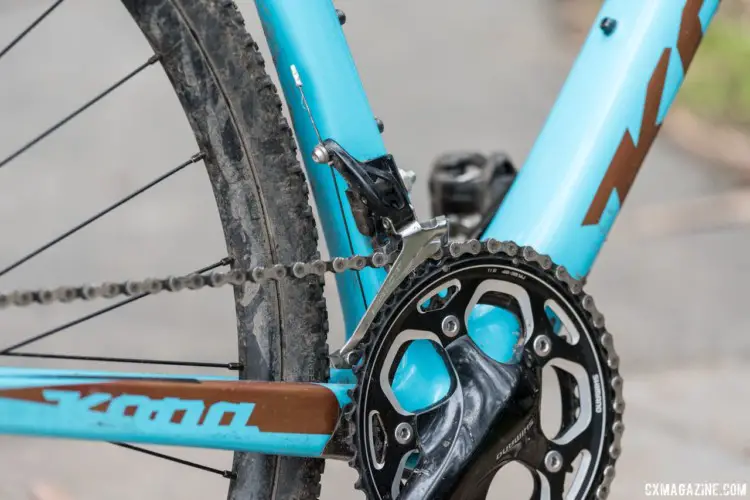
The Major Jake comes stock with a Shimano 105 5800 drivetrain and Shimano RS500 crankset with 46/36t chain rings. 2018 Kona Major Jake cyclocross bike. © C. Lee / Cyclocross Magazine
The ultimate question with a race bike like the Major Jake is how its handling affects race performance. After riding the Major Jake last season, the answer is it depends on the course.
If there are a lot of steep downhill sections and technical terrain, the Major Jake could provide an advantage thanks to the confidence inspired by the front end. However, if there are a lot of chicanes or fast sweepers, a steeper, road-like front end that responds quicker to steering input and weight changes can be an advantage over the Major Jake’s slacker front end.
The bike’s slack front end understeers a bit, which is great in a bermed turn, but it takes more steering input to set your line, which makes the ride feel a little less responsive. On steeper climbs, the front end wanders a bit thanks to the shallower head tube angle and longer trail. However, if you shift your weight forward on the saddle or climb on the drops, the Major Jake climbs just fine and the responsive rear end wastes little of your energy.
Kona definitely went in a different direction with its new 2018 geometry on the Jake line. The slacker front end gives it the feel of a trail bike, and if that is what you are looking for in a cyclocross bike, the Major Jake is probably worth a major look. The same is true if you are looking for a cyclocross race bike that can double up as a gravel crossover.
The Verdict
The $3,000 Kona Major Jake comes with a Shimano 105 build and a stock build that weighs almost 21 pounds. Compared to other bikes we have recently reviewed—for example, the $3,200, 17.8 pound Canyon Inflite CF SLX 9.0—the Major Jake does not sound like a bargain. The bike does share a frame with the high-end Super Jake, and Kona gave it a modern makeover, but flat mount brakes and thru-axles are now ubiquitous on production cyclocross bikes.
If the Major Jake does stand apart, it is in its slack front end and increased trail. The broader wheelbase gave the Major Jake the feeling of a trail bike that inspired confidence on descents and technical terrain during our test riding.
If your cyclocross riding takes you to courses with a lot of climbing and technical features, Kona’s re-designed geometry might provide a better ride than other bikes. Conversely, if your cyclocross racing takes you to parks with sweeping turns, the benefits of the new design might be negated.
We always like to keep our eyes on the suitability of cyclocross bikes for doubling as gravel platforms. Kona offers the Rove gravel bike in several different builds, but with good tire clearance and the slack front end, the Major Jake felt like a bike we would be willing to put higher volume tires on and take out for longer gravel grinds.
For more on the Kona Major Jake, see the specs and photo gallery below.
2018 Kona Major Jake Specifications
MSRP: $2,999
Frame: Kona Carbon Fiber monocoque
Fork: Kona Carbon Fiber with carbon steerer: 1 ⅛" -1 ½"
Weight: 20.8 pounds, no pedals; 12.3lbs without wheels or pedals
Shifters: Shimano ST-RS505 hydraulic 11-speed
Crankset: Shimano RS500 46/36t
Brakes: Shimano BR-R505, Shimano RT-64 rotors 160mm front, 160mm rear
Cockpit: Kona Aluminum, 10cm stem, 42cm flared bar
Seatpost: Kona Aluminum 31.6mm, two-bolt clamp
Saddle: WTB SL8 Pro
Wheels: WTB i19 Asym tubeless aluminum, Formula centerlock disc hubs 14ga rear/15ga front
Tires: Donnelly MXP 700cx33mm tubeless
Warranty: 6 years, frame and fork (original owner)
Country of origin: Taiwan
More Info: konaworld.com








